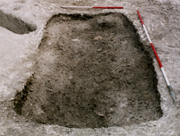|

|
|
The Beaker Period 2500 - 1700 BC |
Return to Gallery
Display
Contents
Finds
from Beaker burials on Thanet
Cottington
Lane
St.
Peter's Refuse Tip
Manston
Runway
North Foreland Avenue
QEQM Hospital Margate
|

|
Finds from
Beaker burials on Thanet
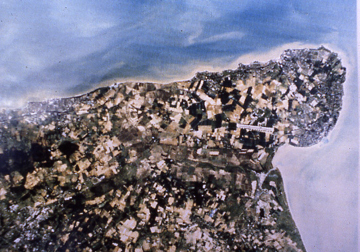
Sattelite
Image of East Kent and the Isle of Thanet
Copyright unknown

|
Artefact
scales in centimetre divisions
Feature scales in 0.1 and 0.5
metre divisions
|
|
This display shows some of the
finds recovered from Thanet Beaker burials.
Occasional
Beaker sherds have been found in various
contexts from sites across Thanet but complete vessels tend to
occur only in graves.
On available evidence
twelve certain discoveries of Beaker burials are recorded on Thanet and there may have been at
least thirteen. This is no doubt an underestimate of the true total of
Beaker burials.
|
|
|
Cottington Lane,
Ebbsfleet |
|
|
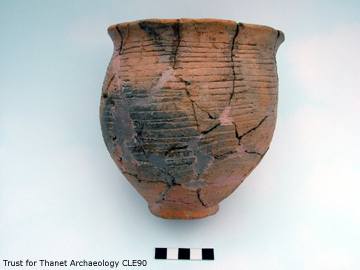
|
|
|
The Beaker
shown above was discovered
during excavations by the Trust for Thanet
Archaeology at Ebbsfleet in 1990. It
accompanied a burial which was found beside
a much later
Roman foundation.
This building had intruded
on part of the grave and
had only narrowly missed destroying it altogether! One wonders how many other
burials of
the period have been destroyed by later development across the Island?
Radiocarbon-dating
of the burial associated with the Beaker places it between 2195-1880 BC.
|
|
|
St. Peter's Refuse Tip |
|
|
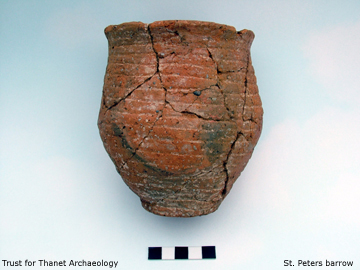
|
|
|
Pictured above is a Beaker
found in a roundbarrow during excavations at St. Peter's Refuse Tip in
1969/71. The vessel was accompanied by an archer’s wristguard
(shown below).
The wristguard
is made of a non-local mudstone. This would have been a prestigious
object for the owner and is the only one known from Thanet. At least
four others have been found in the rest of Kent (Smythe 2006).
|
|
|
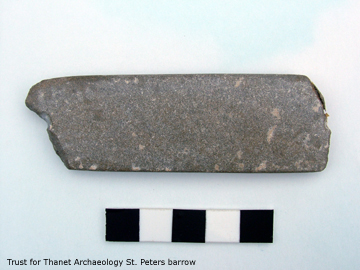
|
|
|
The use of Beakers was not
restricted to high status or prestigious contexts, they were used in
everyday domestic roles as well. Beaker settlements are rarely
encountered however and appear to be as elusive
as those of the Neolithic period.
This has been taken to
indicate that both the Neolithic and Beaker-using people lived a mobile
‘transhumance’ lifestyle. It may also be that archaeologists have
not been looking in the right places! However on current evidence it
does seem that the
practice of settled farming in clearly-defined farmsteads did not
become well established until the
Middle Bronze Age.
|
|
|
Manston Runway Approach |
|
|
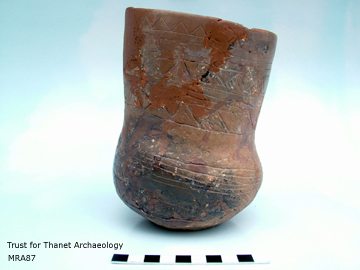
|
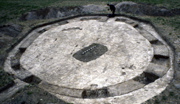
Manston Runway
Approach roundbarrow
Scale in 0.1 metre divisions
Photo by TAU
Photographer unknown
|
|
The pot above was recovered
from a roundbarrow under the approach to Manston Airport. The Beaker
accompanied the
burial of a slightly built adult, laid north/south with their head
facing
east.
The Beaker is of a ‘Late’
form called ‘Long Necked’. This may have been an indigenous development
from the
‘Short-Necked’ Beakers which originated in the Netherlands.
The vessel is asymmetrical
and
rather poorly and carelessly decorated; unusual for these generally
high-quality vessels.
Radiocarbon-dating places
this Beaker between 2140-1885 BC.
|
|
|
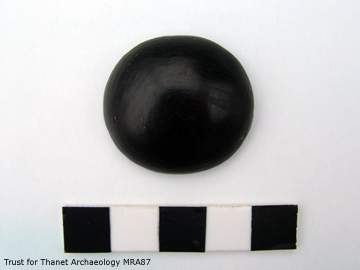
|
|
|
Two other
typical Beaker
grave-goods were included with this burial – a jet button (pictured
above and below) and a flint knife (pictured further below). |
Look closely and you'll see the many
cut-marks and scratches which mark the surface of the reverse side of
this button and were a result of its manufacture
|
|
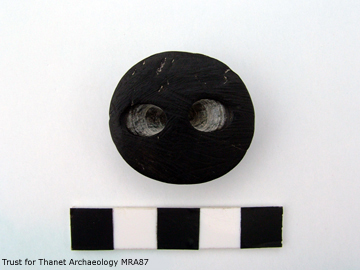
|
|
|
The jet button has been
perforated by two holes which form a ‘V’ and allow it to be tied to a
garment. The raw material for this object comes from the area around Whitby.
It is the only button known
to have
been found in a Beaker grave on Thanet.
|
|
|
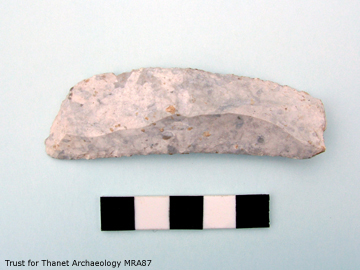 |
|
|
As grave goods such
buttons usually occur as single examples only. That may be a reflection
of their value and cost at that time. It is likely that their
'display-value' far outweighed their practical function.
|
|
|
North Foreland
Avenue, Broadstairs |
|
|
The Beaker below was
discovered in 2004 on a development in North Foreland
Avenue, Broadstairs.
It came from a roundbarrow and accompanied the burial of a woman who
was probably at least 40. The Beaker is also of the 'Late',
'Long-Necked'
variety and has an associated radiocarbon-date of 2350-2130 BC. |
|
|
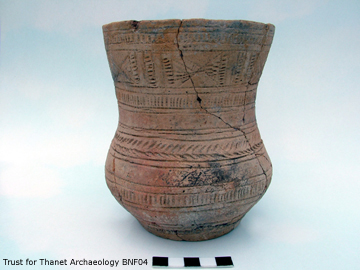
|
|
|
It is well-made and well
decorated, but is not perfect.
The vessel has a large hole
near the base which was present when the pot was buried.
This may have been
broken as part of the burial ritual. The missing pieces were
not
included in the grave, however.
|
|
|
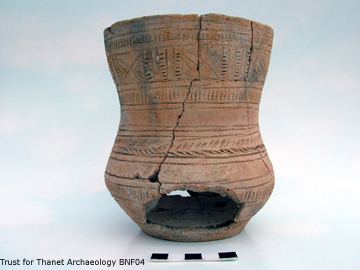
|
North Foreland Beaker
grave
|
|
As you can see from the
image of the burial below, the woman was buried in a ‘crouched’
position typical of Prehistoric inhumation burials. The soils which
filled the grave (see picture left) suggest that she may have been
buried in a wooden
coffin-like structure.
The photograph below shows
a
deposit of chalk rubble around the top left and bottom right-hand
corners of the grave. This formed the primary backfilling deposit. The
steepness of its edges around the top left-hand corner suggest that it
must have butted against a structure that surrounded her body.
|
Scales in 0.5 metre divisions
|
|
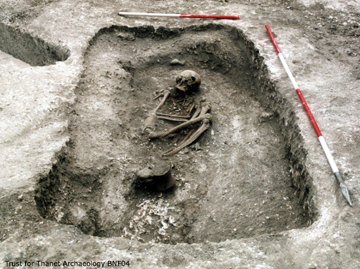
|
|
|
This part of North Foreland
saw the construction of several roundbarrows
in the Earlier Bronze Age, following a lead that may have begun in the
Late Neolithic. It seems to have become the focus for a cemetery
complex for the area's Earlier Bronze Age communities.
More
probably await discovery in the gardens around the North Foreland Estate!
|
|
|
QEQM Hospital, Margate
|
Scale in 0.1 metre divisions
Photo by Susan Deacon (TTA)
|
|
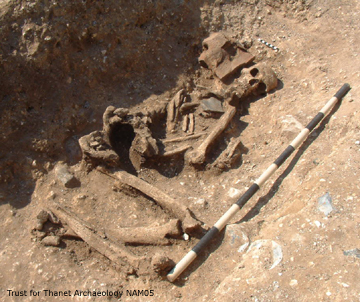
|
|
|
Pictured above and below is
the most recent Beaker burial to have been found on Thanet. It was
discovered
on the 1st June 2005 on a development site
adjacent to the QEQM Hospital in Margate and came hot on the heels of the
North Foreland Beaker, found the previous November.
This vessel also appears
to have a large hole in its side. It is not known whether the missing
sherds were incorporated within the grave though, because the soft and
friable condition of the pot fragments make it
virtually unrestorable.
The Beaker is of an 'Early Style' and has an associated
radiocarbon-date of 2460-2200 BC; the earliest potential date yet
associated with a Thanet Beaker.
|
Photo by Susan Deacon (TTA)
|
|
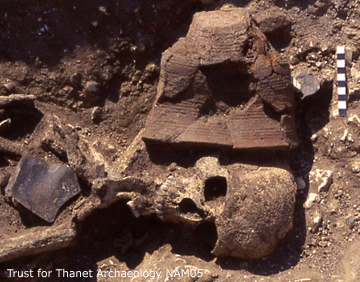
|
|
|
This burial contained three
barbed and tanged flint arrowheads
(pictured
below) which accompanied the 'Bell' Beaker.
This type of
Beaker is often associated with archery grave-goods, but the inclusion
of arrowheads is a first for a Thanet Beaker burial.
They
may be only the second (possibly the third) such association in Kent and likely comprise
the largest single assemblage recovered from a Beaker grave.
|
|
|
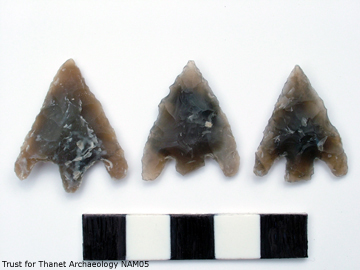
|
|
|
The first arrowhead to
appear was discovered by our Webmeister
and Deputy Director - Ges Moody. It was a
magic moment for all those present!
The arrowheads appear fresh
and un-used and were possibly made specifically to be deposited with
the
body.
|
Scale in 0.1 metre divisions
Photo by TTA
|
|
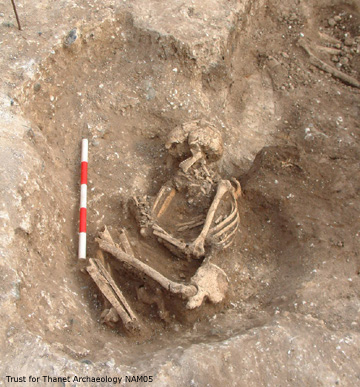
|
|
|
The Beaker burial was
accompanied by a secondary inhumation (pictured above) cut through the
northern (head) end of the primary burial.
The later individual was
female, possibly between 25-35 years of age. She was
laid out the opposite way round to the earlier burial, but this allowed
her to share the same east-facing orientation. Perhaps the position was
also to allow her to be close to the
Beaker as well.
Does this suggest that
there was there a close association between these two people in life?
The later burial was also
accompanied by a flint arrowhead, though of much cruder form (see
below). This
object
was discovered when the skeleton was being cleaned; it was found
inside the skull!
|
|
|
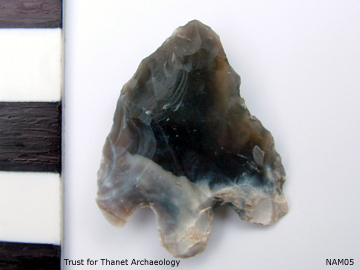
|
|
|
Top
|
|
|
Abbreviations
TAU - Thanet Archaeological
Unit.
TTA - Trust for Thanet
Archaeology.
|
|
|
Bibliography
Ashbee P. 2005. Prehistoric Kent. Tempus.
Clark D.L. 1970. Beaker Pottery of Great Britain and Ireland. Cambridge University Press.
Gardner O.W. and Moody G.A. 2006.
Queen Elizabeth the Queen Mother Hospital, St. Peter's Road, Margate,
Kent. Trust for Thanet Archaeology report.
Hart
P.C. 2005. Beauforts,
North Foreland Avenue, Broadstairs, Kent. Trust for Thanet Archaeology report.
Jay L. 1995. Thanet Beakers. Trust for Thanet Archaeology.
Smythe J. 2006. An Early Bronze Age wristguard from Kent. Kent Archaeological Society Newsletter
n0.69. p.16.
|
|
|
The
text is the responsibility of the author; the photographs are by
the author unless otherwise
stated.
|
|
|
Paul Hart
Version 1 - Posted 01.04.06
Version 2 - Posted 09.04.06
Version 3 - Posted 18.05.06
Version 4 - Posted 13.06.06
Version 6 - Posted 21.07.06
Version 7 - Posted 16.12.06
|
All
content © Trust for Thanet Archaeology
|












